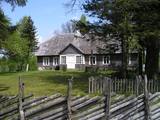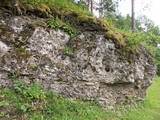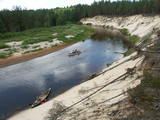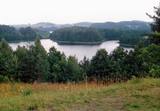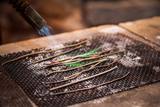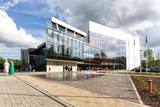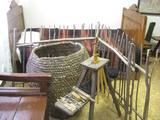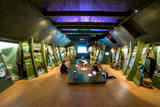| Nr | Name | Beschreibung |
|---|---|---|
|
Handgemachtes Salz- und Süßgebäck. In der Sommersaison bieten wir hausgemachtes Essen an, das aus der nächsten Umgebung angebauten Gemüse und geangelten Fisch zubereitet wird. |
||
|
Das Museum wurde 1991 gegründet. Im Geburtshof von S. Darius wurden Haus und Speicher der Eltern wiederaufgebaut. In beiden Gebäuden gibt es jetzt Ausstellungen. In einem erzählt die Ausstellung über die Geschichte der Luftfahrt in Litauen und das Leben von Darius, während die andere Ausstellung dem traditionellen niederlitauischen Haushalt gewidmet ist. Neben dem Museum gibt es einen Campingplatz, wo man sich erholen und auch für längere Zeit niederlassen kann.
|
||
|
Das ist ein Abschnitt des Gauja – Flusses mit Stromschnellen an einigen Stellen. Es erstreckt sich von Vidaga bis zum Ort, wo der Fluss Vecpalsa indie Gauja fließt. Entlang der Gauja und seinen Nebenflüssen kann man Dolomitaufschlüsse an seinen Ufern sehen, die größten sind die Randati – Klippen. Das Territorium wurde vor allem eingerichtet, um die verschiedenen Arten an Wald, Wiesen, Aufschlüssen und ihre Habitate zu schützen. Das ist ein interessanter Abschnitt des zentralen Teils der Gauja, vor allem für Leute, die die schöne Landschaft genießen möchten und für Wassertouristen.
|
||
|
Redzamas pa lielu gabalu Vecumnieku – Skaistkalnes un Stelpes ceļu krustojuma tuvumā. Šīs Holdandes tipa vējdzirnavas uzcēla 1903. gadā. Sākot ar 20. gs. 30. gadiem dzirnavas darbojas ar elektrības palīdzību. Līdz mūsdienām ir saglabājušies vējdzirnavu vēsturiskie mehānismi. Kādreiz daudzie vējdzirnavu stāvi bija raksturīga Zemgales vēsturiskajam novadam, ko pamatoti dēvē par Latvijas „maizes klēti”. Diemžēl līdz mūsdienām ir saglabājušies tikai daži. Šīs vējdzirnavas ir apskatāmas tikai no ceļa malas.Ap 8 km rietumos (Iecavas virziens) redzamas vēl vienas – Kāravu vējdzirnavas. |
||
|
Dieses Gebiet befindet sich im Süden des Flusses Irbe und ist einzigartig mit mehr oder weniger unberührten Wäldern und Dünen. Die Irbe hat ein System alter Nebenflüsse. Der Dižpurvs – Sumpf liegt parallel zur Küste. Die Irbe ist in den letzten Jahren bei Wassersportlern beliebt geworden, jedoch ist die touristische Infrastruktur noch ungenügend entwickelt.
|
||
|
Das Restaurant befindet sich im Hotel Park Hotel Latgola und bietet aus seinem neunten Stockwerk eine weite Aussicht auf die Stadt, sowie lettgallische Gerichte und Gerichte aus der Küche der Welt an. Lettische Küche: Ostseeheringssalat, Salat aus Kümmelkäse, lettgallische Vorspeisen mit Speck, Kartoffel, Käse und eingelegten Gurken, Schweinrippen mit Sauerkraut, Kartoffelpfannkuchen, Kartoffelklöße, Bohnen im Topf, Bratwürste, Quarkfladen. Das besondere Gericht: Krautsuppe mit Steinpilzen. |
||
|
Der bäuerliche Betrieb stellt Joghurt, Quark, saure Sahne, Sahne und Käse aus der Milch der eigenen Kuhherde (70 Kühe) her. An jedem Freitag kann man die Erzeugnisse vor Ort im bäuerlichen Betrieb kaufen. |
||
|
The museum offers information about local manufacturing traditions, as well as products from SIA Naukšēni – various oils (made of rapeseed and hempseed), ten non-alcoholic beverages (kvass, mineral water), as well as tastings of homemade wine. Some of the products can be purchased. |
||
|
Eine aus Holz von den einheimischen Handwerkern nach der Finanzierung der Grafen Plater gebaute Kirche stammte von 1655 bis 1658 als eine nicht große einschiffige Basilika. Das einzigartige kulturhistorische Denkmal gilt als eine der ältesten Holzkirchen in Lettgallen. Die Schnitzerei des Zentralaltars in den Formen des Barocks wurde von den Meistern der Schnitzereischule von Stelmuže erschaffen. Im Seitenaltar befindet sich das Bild aus dem 18. Jahrhundert “St. Maria Magdalena”. Die Kirche wurde 1698 auf den jetzigen Platz – am rechten Daugava-Ufer befördert. Das Gebäude wurde mehrmals – 1890 und 1918 erneuert. Um die Kirche herum befindet sich einen Steinzaun aus dem Ende des 17. Jahrhunderts mit einem separat stehenden Glockenturm aus der Mitte des 19. Jahrhunderts, der 2002 restauriert wurde. Gemäß verschiedenen Informationsquellen kann man behaupten, dass die Gemeinde von Indrica die älteste in Lettgallen ist. |
||
|
Atrodas Lubāna dienvidu krastā pie dambja un Īdeņas kanāla, no kura var aplūkot „tipiskas” mitrāju ainavas – niedrājus, aplūstošus krūmājus, mitras pļavas, aizaugušo ezeru. |
||
|
Vermutlich ein heidnischer Hügel. Schöner Blick auf die 6 Seenlandschaften. Ein Symbol vom Nationalpark. |
||
|
Apmeklētājiem tiek piedāvāta ekskursija ar stāstiem par Limbažiem, kas kādā veidā saistīti ar sudrabu. Ekskursijas laikā iespējams apskatīt paraugdemonstrējumus lodēšanā. Sadarbībā ar juvelieriem, darbnīcā būs iespējas apgūt prasmes darbam ar misiņu un sudrabu, tiks piedāvātas arī meistarklases. Pēc iepriekšējas pieteikšanās grupām būs pieejamas arī O.Auzera lekcijas par sudraba ietekmi uz veselību. Ekspozīcija atvērta apmeklētājiem no trešdienas līdz svētdienai no pl.10:00-17:00, citā laikā grupām- pēc iepriekšēja pieteikuma. Ieejas maksa: |
||
|
Ein historischer Weg von Rīga nach Liepāja durch Jelgava, Dobele, Saldus, Skrunda, Durbe un Grobiņa ist schon seit dem 13. Jh. bekannt. Vom Altertum zeugen auch die Reste der skandinavischen Siedlung in der Nähe von Grobiņa. |
||
|
The Preiļi Estate is in the southern part of Preiļi. During the Soviet era, the mansion was home to a variety of institutions. A fire burned much of the upper part of the building in 1978. The mansion was never restored, and it can only be viewed from the outside. Around it, however, is one of Latvia’s most outstanding landscape parks (mid-19th century). Irēna Kjarkuža offers interesting tours of the state, with interesting legends and songs in the Lettigalian language. |
||
|
Ilmārs Vecelis takes part in the “Potter School” of the Latvian Cultural Fund and, therefore, uses ancient pottery methods that have been tested over the course of many centuries in Latgale. You can tour his workshop, attend the opening of the kiln, try your own hand at the craft, and commission and purchase finished ceramics products. |
||
|
The Liv Coastline involves a series of shoreline villages from Ovīši to Ģipka along the shores of the Baltic Sea and the Bay of Rīga. Like Latvians, Livs are an indigenous population in Latvia, with ancestors who lived here at least 5,000 years ago. They populated extensive parts of Kurzeme and Vidzeme, and the area in which they lived the longest was Northern Kurzeme, on the shores of the Baltic Sea. Today visitors to the Liv Coastline mill meet real Liv fishermen, feel the aroma of smoked fish, enjoy traditional dishes, look at diverse ancient fences, learn about the reticent charm of the local landscape, enjoy the place where two seas, birds and people meet at Cape Kolka, hear the Liv dialect of the Latvian language, see rounded hillocks and swampy areas, visit the Šlītere lighthouse, and see the green-white-blue Liv flag, red bilberries, bird migration routes and blue cows. The oldest evidence of the life of Livs can be found in the Liv centres. The Liv language and culture are still alive in place names, handicrafts, folk costumes, and the world view and lifestyle of people who live in the area. The Liv language and cultural values are part of Latvia's national cultural heritage, and traditional Liv culture is part of the Latvian Canon of Culture. |
||
|
GORS, The Embassy of Latgale is located in the heart of Latgale region – Rezekne city. It is a place where the story of Latgale is both created and told. Cultural heritage and ancient values, traditions and creation, the language and events, the most significant global trends, art, culture, dance and songs converge here. A centre of culture, concert halls, film theatre, a place of residence for artists, an exhibition space for art, a restaurant for the enjoyment of life, a place for experiments with all the senses. |
||
|
Local History Museum of Nautrēni. Permanent exposition of the
local history of the district, school and parish.
Working hours: on request |
||
|
Ein Stadtbaudenkmal der 17 – 19 Jahrhunderte von staatlicher Bedeutung. In den Umgebungen der Straßen Jelgavas und Rātūža ist eine ehemalige Straßenplanung erhalten, die eine geschlossene Bebauung des Stadtviertels bildet. In Jaunjelgava befinden sich lutherische, katholische, orthodoxe und baptistische Kirchen. Eins der hervorragenden Architekturdenkmäler ist das 1912 in den Jugendstilformen gebaute Rathaus. Bis heutzutage ist keine der fünf Synagogen erhalten. Entlang des historischen Zentrums von Jaunjelgava ist am Daugava-Ufer eine Uferpromenade errichtet – ein beliebter Platz der Stadtbewohner für Spaziergänge, Erholung und Baden. |
||
|
The Baltic Sea gave this territory one of the old names of Jūrkalne – Felixberg, and people still talk about the interesting legend that is the origin of the name. Several wrecked ships have been found in the Baltic Sea off the coast of Jūrkalne. An exhibition in the museum visualises the underwater world as the deck of a ship that has sunk into the depths of the sea. The exhibition focuses on the cultural and historical heritage of underwater Latvia, allowing visitors to learn all about the history of sailing ships, steamships and other objects that have been raised from the depths. Small children will start to learn about the underwater world, and researchers with broader knowledge will find something new here. |
||


